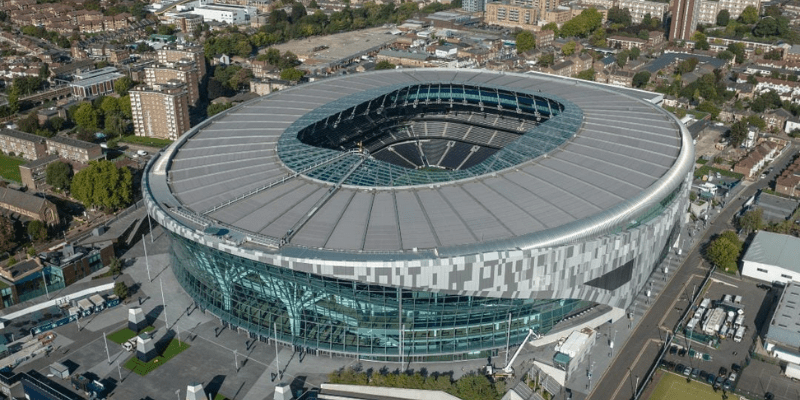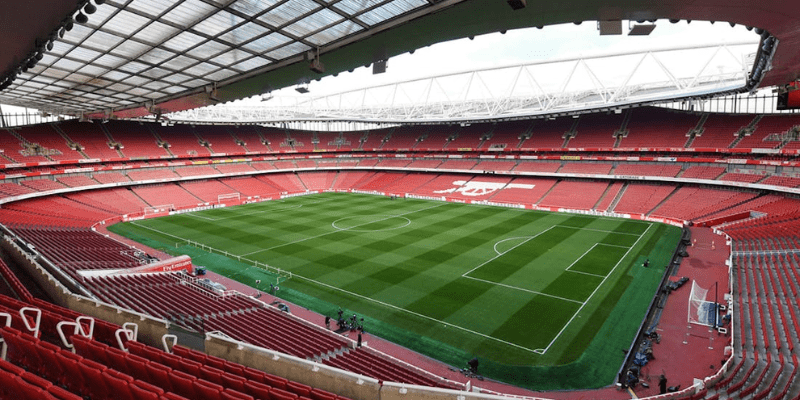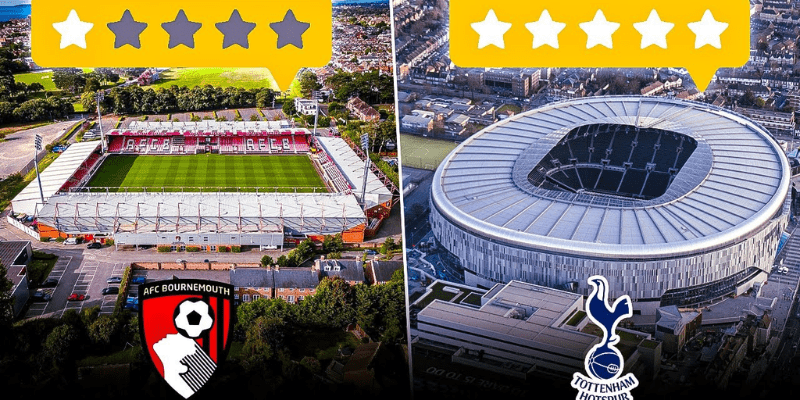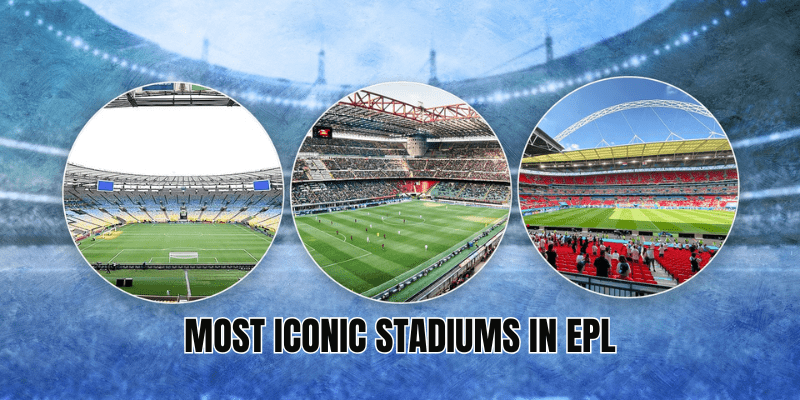The roar of the crowd. The weight of history in every brick. In the most iconic stadiums in EPL, you don’t just watch football — you become part of the story. Today, AnnuGoal will take you on a tour of the great temples of the Premier League — places that echo with legends, chants, heartbreaks, and triumphs.
What Makes a Stadium “Iconic”?

Before naming names, let’s define what gives a ground timeless status:
- History & continuity — decades (or over a century) of matches, legends, and memories.
- Atmosphere & fan culture — a cauldron of noise, passion, identity.
- Memorable moments — title-deciders, epic comebacks, derbies.
- Design & architecture — quirks, capacity, expansions through eras.
- Cultural significance — beyond football: in music, media, local identity.
So when we say most iconic stadiums in EPL, we mean those grounds that live in the collective memory of fans, not just current capacities or modern features.
The Legends: Icons That Defy Time
These stadiums are headliners — they carry weight even in football’s global era.
Old Trafford (Manchester United)
Nicknamed the “Theatre of Dreams,” Old Trafford has been United’s home since 1910.
- Capacity: ~74,197, making it one of the largest club stadiums in England.
- Famous for: the Busby Babes era, the Munich air disaster memorial, the treble season of 1999, countless title celebrations.
- Why iconic: It’s not just size — it’s the sense that ghosts of legends still linger in every stand. When Sir Alex, Cantona, Beckham, Ronaldo, and others roamed here, it etched itself into football lore.
Anfield
If Old Trafford is majesty, Anfield is fire.
- Capacity: ~61,276 after modern renovations. edia])
- Famous for: “You’ll Never Walk Alone,” the Kop, wars and comebacks, European nights when time seems to stop.
- Why iconic: The passion is almost tactile. Moments like Istanbul 2005 made Anfield both fortress and altar.
Stamford Bridge
A more understated, but still legendary, presence.
- Capacity: ~40,044 in its modern form.
- History: Originally built in 1877.
- Why iconic: The blend of old and new. It has hosted rugby, athletics, and more. Its deep roots and central London footprint make it symbolic of evolution — always changing, never losing identity.
Modern Marvels with Iconic Potential

These new or renovated stadiums may not have a century behind them, but they already make the cut for their ambition, atmosphere, or landmark moments.
Tottenham Hotspur Stadium
Opened in 2019, it’s the blueprint for a modern multi-use arena.
- Capacity: ~62,850.
- Features: retractable pitch (to host NFL), world’s longest stadium bar, design pushing fan comfort.
- Why iconic: This is future-proof design. Already has hosted major matches, showing it can link tradition with innovation.
Etihad Stadium (Manchester City)
While more modern than historic, Etihad has built memories fast.
- Originally built for the 2002 Commonwealth Games, later converted. 0min.com])
- Why it resonates: City’s rise in the last decade (titles, European nights) gave this ground meaning. It’s no longer just a modern arena — it’s part of a football dynasty.
Forgotten Temples & Farewell Legends

In talking about iconic stadiums in EPL, one must also remember those on their final chapters.
Goodison Park (Everton)
One of the grand old ladies of English football, Everton’s Goodison Park is set for retirement.
- Opened: 1892
- Legacy: Pubs on corners, old terraces, deep local identity.
- Why it made the list: Even in farewell, Goodison carried more than bricks — it carried memories of classic league battles, local life, and fans’ generational ties.
Villa Park, Elland Road, and Others
These aren’t always on every modern list, but their legacy is undeniable.
- Villa Park: hosted FA Cup finals and historic matches.
- Elland Road: iconic in Yorkshire culture, hosting ups and downs for Leeds.
- Why they matter: Iconic stadiums are not only about glamour — many earned scars, endured relegations, saw reinventions. Their resonance with fans is deep.
Comparing Arenas: A Snapshot
| Stadium | Club / City | Capacity* | Era & Key Traits |
| Old Trafford | Manchester United | ~74,200 | Classic, massive, full of history |
| Anfield | Liverpool | ~61,300 | Passion, Kop, European aura |
| Stamford Bridge | Chelsea | ~40,000 | Central, evolving, rooted in long history |
| Tottenham Hotspur Stadium | Tottenham | ~62,0 | Modern, multi-use, technology-driven |
| Etihad Stadium | Manchester City | (varies) | Sleek, modern, success-driven |
| Goodison Park | Everton | N/A (retiring) | Nostalgia-laden, closing chapter |
| Villa Park / Elland Road | Aston Villa / Leeds | (40–50k scale) | Regional icons with rich legacies |
* Capacities are approximate in current configurations, excluding temporary adjustments.
Why These Stadiums Matter to Fans (Beyond the Game)
- Emotional Anchors — They are places where life milestones are celebrated: first match, first goal seen, heartbreaks, reunions.
- Cultural Symbols — They tie to cities, working-class roots, local identities.
- Media & Pop Culture — Featured in films, video games, documentaries, songs.
- Evolution of Football — They show how football grew — from terracing to all-seater,. Tourism & Pilgrimage — A pilgrimage to Old Trafford or Anfield is a goal on many fans’ bucket lists.
Location Matters: Where Atmosphere Beats Size
Sometimes a mid-size stadium becomes iconic because the crowd lives in it.
- Craven Cottage: quaint, riverside, full of character though modest in scale.
- St James’ Park: tied to Newcastle’s identity, Geordie voice in stands.
- The City Ground, Villa Park, St. Mary’s: smaller stadiums with fierce home atmospheres and long heritage.
Because in many lists of “best stadiums in Premier League,” the top names always include Old Trafford, Anfield, Stamford Bridge — but local fans swear by their own grounds too.
Challenges & Evolution: Keeping Iconic Alive
Iconic status isn’t static. Stadiums must evolve or fade. Some key pressures:
- Renovation vs Respecting history: Expanding capacity while preserving the soul is a delicate balance.
- Commercial demands: Hospitality suites, commercial zones, sponsorships, multifunction events.
- Accessibility & safety upgrades: Regulations change, and old grounds mustdapt.
- Relocation or rebuilding: Some clubs build new stadiums — risking loss of “home” feeling.
- Fan identity preservation: The unique quirks of terraces, chants, seat layouts, and local flavor must survive.
Goodison’s closure is a case in point — fans fight to preserve memory even as ground changes are inevitable.
Final Thoughts
The most iconic stadiums in EPL aren’t just about capacity or modern amenities — they are living, breathing vessels of football’s soul. From Old Trafford’s grandeur, Anfield’s fire, Stamford Bridge’s evolution, to Tottenham’s futuristic ambition — each has a story, each holds magic.
If you’re planning a trip, a dream list, or just want to feel the pulse of Premier League heritage — make these stadiums your guideposts. Let AnnuGoal be your companion as you chase the echoes of chants, the shadows of legends, and the timeless magic only a stadium can give.
Ready to dive deeper? I can map routes between stadiums, suggest matchday itineraries, or build your personal “stadium bucket list” — just ask.



